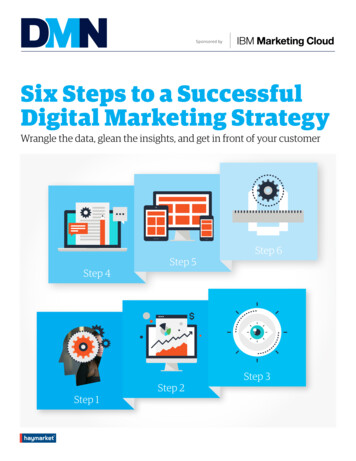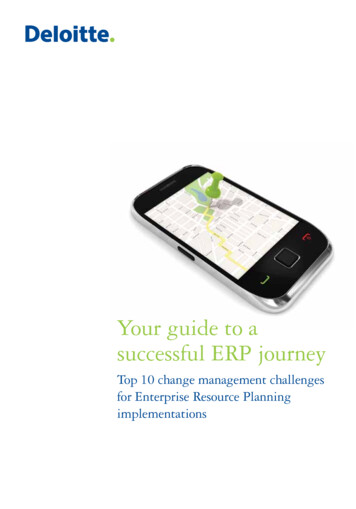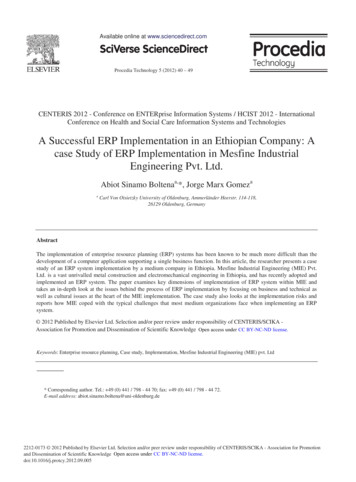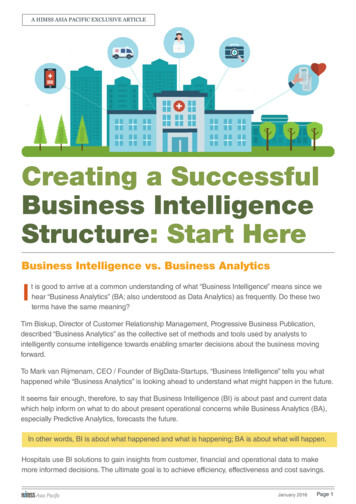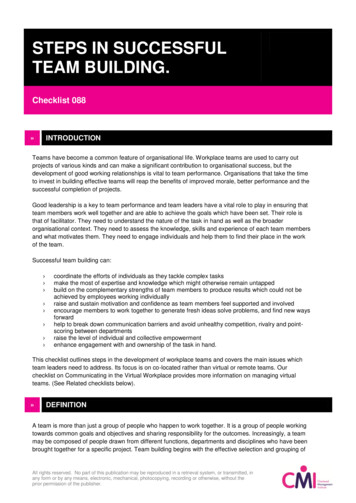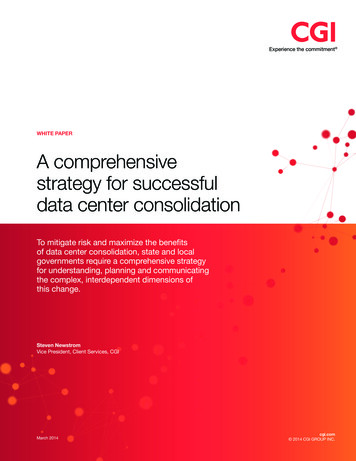
Transcription
Experience the commitment WHITE PAPERA comprehensivestrategy for successfuldata center consolidationTo mitigate risk and maximize the benefitsof data center consolidation, state and localgovernments require a comprehensive strategyfor understanding, planning and communicatingthe complex, interdependent dimensions ofthis change.Steven NewstromVice President, Client Services, CGIMarch 2014cgi.com 2014 CGI GROUP INC.
Executive summaryData center consolidation is an increasingly popular approach to achieving costsavings and other efficiencies in state and local government, but the actual processof shutting down and relocating numerous hardware and software components cancreate complex challenges across multiple dimensions. Many consolidation projectshave suffered cost overruns, delays and disappointing results, which are drivenby hidden interdependencies, unforeseen requirements, and a failure to effectivelycoordinate activities with stakeholders. Because data center consolidation is a oncein-a-career event for most IT professionals, organizations often lack the internalexpertise to anticipate and manage the hundreds of issues that might arise.Based on many years of experience with helping clients reduce their data centerfootprints, CGI has developed a comprehensive consolidation strategy addressing allaspects of data center consolidation. The five components comprising our strategyand approach are:1. Business planning—Establish the objectives and planned end-state2. Discovery mapping—Identify the numerous physical locations, technologies,organizations, services, people and processes that will be impacted by the project3. Dependency mapping—Chart the interdependencies and rippling impacts amongthese many elements4. Execution planning—Acquire the different IT skills, hardware and other resourcesnecessary to address the issues and requirements identified in the mapping phase5. Execution—Migrate servers and applications to the new data centers.Critical to the success of this strategy is an organizational change managementapproach that helps guide consolidation activities through every phase to ensure clearcommunication and stakeholder commitment. This comprehensive approach enablesgovernment leaders to establish and execute a consolidation plan that mitigates risk,limits unpleasant surprises and builds widespread support. It also achieves consolidation’s promised benefits of reduced costs and energy consumption, improved servicesand more efficient use of IT resources.1
Data center consolidation: benefits and challengesFIGURE 1: STATE CIOPRIORITIES FOR 2014Priority strategies,management processesand solutions1. Security2. Consolidation/Optimization3. Cloud Services4. Project & PortfolioManagment5. Strategic IT Planning(Source: NASCIO State CIOSurvey November 2013)Many cash-strapped state and local governments face high operational costs andcapital investments because they are running more data centers than they need. Insome organizations, “closet” data centers have multiplied and IT departments arestruggling to halt the unchecked growth of servers and infrastructure. With pressure toreduce IT budgets, consolidating data centers has become a top priority among CIOsin both state and local governments. Figure 1 shows consolidation as the number twopriority for state CIOs for 2014.In some initiatives under consideration, governments will continue to own and run theirdata centers after consolidation, while others will use the process as a stepping stoneto outsource some or all of their infrastructure and services. In addition, some governments intend to implement virtualization technologies and cloud computing as partof the consolidation effort. However, regardless of the approach taken, all are hopingto achieve significant cost reductions and efficiencies by decreasing facility, personnel and power requirements, while improving overall IT management and delivery ofservices to both citizens and agency customers.COMPLEXITIES OFTEN UNDERESTIMATEDConsolidating data centers is fraught with risk. Numerous commercial, federal, stateand local organizations have experienced lengthy delays, cost overruns (some totalingmore than 100 million), service degradation and project cancellations because theydid not fully understand consolidation’s many variables and complexities. For example,a Western state’s data center consolidation project failed to achieve its objectives dueto data security issues and a lack of adequate electrical power. Other common challenges include: Requirements for space are often dramatically altered at the new data centerlocations Legacy applications may not operate on the new infrastructure Specialized IT skills and hardware may be needed to keep applications runningduring or even after the move Uncoordinated service outages during the transition can disrupt mission-criticalapplications of customer agencies.In short, consolidating and relocating data centers entails more than simply shuttingdown infrastructure and virtualizing servers. Underestimating the complexity—such asthe time it will take, the hardware needed and the skills required to do the job—can befatal to a project’s success.2
A comprehensive consolidation strategyConsolidation involves more than transferring applications and data from one set ofservers to another, or the moving of servers from one facility to another. Transitionsmust occur without disrupting day-to-day operations or mission-critical applications,and services must function seamlessly in the new consolidated environment. Inaddition, every organization has a unique set of requirements for its operations,security and the downtime it can tolerate during the transition.ExecutionExecution planningDependency mappingDiscovery mappingA comprehensive consolidation strategy helps clients understand their uniquerequirements and mitigate challenges through:Business planning1. Business planning—Establishing the business objectives and technology goals.This includes assessing the agency’s or department’s business requirements fordata processing, storage and back-up, continuity of operations, future expansion,etc. Such planning also identifies the new organizational structures and processesthat will be needed to support the consolidated data centers.2. Discovery mapping—Identifying the numerous facilities, technologies, organizations, services, people and processes that will be impacted by the project. Thisincludes understanding the business requirements for IT services and the impactof the transition on mission-critical services.3. Dependency mapping—Charting the interdependencies and rippling impactsamong these many elements. Some applications depend on other applicationsor infrastructure. Similarly, infrastructure may depend on certain applicationsto function. All of the interdependencies must be mapped to create a transitionschedule that provides minimal disruption and ensures that mission-critical servicesare delivered as needed. Conducting due diligence on service outages is a crucialbut often overlooked planning activity.4. Execution planning—Acquiring the different skills, hardware and other resourcesthat will be necessary to address all issues and requirements identified by themapping phase. Expertise in virtualization technologies is critical, as is expertisein capacity planning, performance management and data security. In addition,agencies and departments may also need help with transferring data to the newdata centers and, in some instances, physically moving servers.5. Execution—Carrying out the plan using effective organizational change management principles and practices to gain buy-in and commitment throughout theorganization. Often overlooked is the importance of scheduling dress rehearsals ordry runs before the actual consolidation. These can provide valuable lessons andhelp agencies and departments uncover and resolve unanticipated problems beforeembarking on the real data center consolidation.3
Critical success factors: alignment, commitment andcommunicationStudies of complex IT implementations demonstrate that project success dependsgreatly on the ability of the organization’s people—its leaders, employees and usercommunities—to embrace the planned changes. For example, in a NASCIO survey,62 percent of state CIOs said their state’s data center consolidation initiativesexperienced “pervasive culture/resistance to change.”1State and local governments can realize the most benefit from a data center consolidation by winning stakeholder commitment to the project’s goals and facilitating thetransition to the new ways of doing business. This requires an organizational changemanagement (OCM) approach that is tailored to the specific pace and requirements ofconsolidation to ensure that the right stakeholders are involved in each phase of theproject’s planning and execution.Throughout the planning and execution of the data center consolidation, CGI’s OCMapproach helps facilitate policy, communication, governance and stakeholder commitment to increase the likelihood that consolidation will deliver the desired results. Ourapproach compromises five basic steps:1. Assess change—Identifying the key business issues regarding the agency’s ordepartment’s readiness and capability for change. Often cultural and bureaucraticprocesses supporting earlier practices must be relinquished; thus, it is important toidentify the new relationships and processes, so plans can be made to facilitate thetransition and reinforce new behaviors.2. Align executives—Ensuring agreement among program, agency and/or departmentheads about the vision and goals of the project. Often leaders from differentagencies have differing—and even incompatible—ideas about what they want toachieve. Aligning leaders requires agreement on the scope, nature and magnitudeof change, on how to define and measure success, and on how leadership will worktogether to achieve consolidation’s goals. Data center consolidation projects cannotsucceed without executive alignment across the enterprise.3. Translate and communicate—Establishing the strategy for communicating theplanned changes, including training and strategies to keep both leaders and stakeholders aligned. Leaders must communicate a consistent message—tailored to eachstakeholder group and repeated as often as needed—regarding what the changeswill be, how they will impact each stakeholder group and how they will be carried out.The latter point is crucial because organizations often become misaligned on how tocarry out agreed-upon changes.1 “Enterprise Data Center Consolidation in the States: Strategies and Business Justification,”p. 11 (NASCIO, 2007).4
4. Execute plans—Coordinating the execution of strategies for consolidating datacenters and transitioning to new work processes while simultaneously performingday-to-day functions that support operations and mission activities. Changemanagement workshops can help managers handle resistance and lead theirteams through the transition stages.5. Evaluate—Assessing the project’s progress and performance against the successmodel. Change is a dynamic process. Agencies and departments must remainflexible and open to course correction throughout the transition, using metrics,feedback from stakeholders and lessons learned to amend and improve theexecution plan.This approach is based on understanding the pitfalls and key junctures in the datacenter consolidation process, including how and where problems occur—and howto prevent them. It gives government leaders the tools and techniques to keep theirfingers on the pulse of their changing organizations and, when necessary, intervenequickly and effectively to keep the consolidation project on a path toward successfulcompletion.ConclusionState and local governments are moving aggressively to consolidate data centers andassociated IT infrastructure. Some intend to outsource portions of their infrastructureand services as part of the consolidation effort, while others may simply need helpwith planning and executing the consolidation. In addition, some are using consolidation as a platform for broader modernization goals, such as implementing virtualizationtechnologies and migrating applications to cloud services. Each of these paths canachieve significant savings and efficiencies, but consolidation’s benefits will be realizedonly through careful planning and attention to the multitude of interrelated variablesand activities involved.CGI has extensive experience in guiding organizations through data centerconsolidation projects to maximize the benefits while avoiding the problems that haveundermined poorly planned and executed projects. In addition, CGI can help agenciesand departments decide whether and how to virtualize applications and migrate tocloud services.We understand that people, processes, technology, culture and mission responsibilitiesare unique to each environment. Our comprehensive consolidation strategy, includinga proven organizational change management approach, helps agencies and departments identify these unique requirements and create a strategy for efficiently andeffectively consolidating their data centers.IT consolidation involves the interrelated disciplines of data center consolidation,infrastructure consolidation, application portfolio rationalization and multisourcingservices integration. CGI has developed competencies and best practices across allof these dimensions to help state and local governments realize the full benefits of theirconsolidation initiatives.5
11325 Random Hills Road,Fairfax, VA 22030USAcgi.comABOUT THE AUTHORSteven NewstromVice President Client Services, CGIMr. Newstrom is responsible for the development of CGI’s IT consolidationbusiness program supporting U.S. state and local government and commercialclients. Prior to January 2011, he managed the organization responsible forCGI’s U.S. infrastructure services delivery to mor
data center consolidation. To mitigate risk and maximize the benefits . of data center consolidation, state and local governments require a comprehensive strategy for understanding, planning and communicating the complex, interdependent dimensions of this change. Steven Newstrom . Vice President, Client Services, CGI . March 2014. WHITE PAPER. 1. Executive summary Data center consolidation is .File Size: 394KBPage Count: 7
